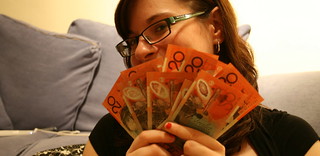
PREV ARTICLE
NEXT ARTICLE
FULL ISSUE
PREV FULL ISSUE
HOW POLYMER BANKNOTES WERE INVENTEDHere's an article outlining the story of how the polymer banknote came to be invented in Australia. Be sure to read the complete
version online - here's an excerpt. -Editor
The project commenced in 1968 and continued until 1988 with the release of the A$10 bicentennial commemorative banknote. But it’s the story behind this story – a personal note of forgeries, underworld figures and CSIRO – that is just as impressive. By April 1966 most of the old imperial banknotes had been removed from circulation, and a new range of state-of-the-art dollars and coins were doing the rounds of the nation’s tills, wallets and pockets. With designs by leading Australian artists and cutting edge security features such as watermarks and metal thread, things couldn’t have been better for the note-issuer, the RBA. But the new notes were not infallible, and it didn’t take long for counterfeiters to strike. By the end of the year, a team of amateurs from suburban Melbourne, armed with simple office equipment and a desire to make some money, were able to produce a batch of fake notes with no intaglio printing, no watermark and no metal thread that would net them almost A$800,000 worth of forgeries. (That figure’s not to be sneezed at – it would be worth A$9.6 million in 2013.) The nucleus of this team were two “regular joes” with no real criminal history: Francis Papworth, an artist from Bentleigh, and Jeffrey Mutton, who owned a failing milk bar in Moorabbin near a printing plant where Papworth worked. As with many great schemes, this one was hatched over a beer – Papworth and Mutton often met at the Boundary Hotel in East Bentleigh. It was January 1966, only a few weeks before the introduction of the dollar, and the two mates were looking for an easy way to reverse their fortunes. Papworth worked at a printing plant … so why not print some money? News of the forgery soon became public, and a period of unrest followed. Instructions were issued by the Reserve Bank on how to spot the forgeries, which were then to be handed to authorities. But anybody turning a note in would not receive a genuine note in return, so many continued to be circulated. A general distrust of A$10 notes permeated Australian society – at one stage, members of the Amalgamated Engineering Union refused to accept them as part of their pay packet. The RBA’s Governor, HC (Nugget) Coombs turned to science – or, more specifically, to CSIRO. The challenge was set: could we create the world’s most secure banknote? After some preliminary planning, the “bank project” began. Coombs originally enlisted seven top Australian scientists – five physicists and two chemists – to help the RBA develop a more secure banknote. They met on April 1, 1968, and despite the date, these were no April fools – the two chemists were Jerry Price, who went on to become chairman of CSIRO, and Sefton Hamann, chief of the CSIRO Division of Applied Chemistry. The group was introduced to the general principles of banknote design and production, and sent off to think about it before reconvening for a second meeting at Thredbo in June 1968. Two more scientists were invited to Thredbo: Neil Lewis, recently retired from Kodak, and David Solomon, a young, award-winning polymer scientist from CSIRO. It was during these first few years that Dr Solomon first hit on the idea of a plastic banknote after being given a business card printed on plastic by a visitor from Japan. Today, there are more than 30 different denominations totalling some three billion polymer notes in service in 22 countries worldwide. To read the complete article, see:
Wayne Homren, Editor The Numismatic Bibliomania Society is a non-profit organization promoting numismatic literature. See our web site at coinbooks.org. To submit items for publication in The E-Sylum, write to the Editor at this address: whomren@gmail.com To subscribe go to: https://my.binhost.com/lists/listinfo/esylum All Rights Reserved. NBS Home Page Contact the NBS webmaster 
|
